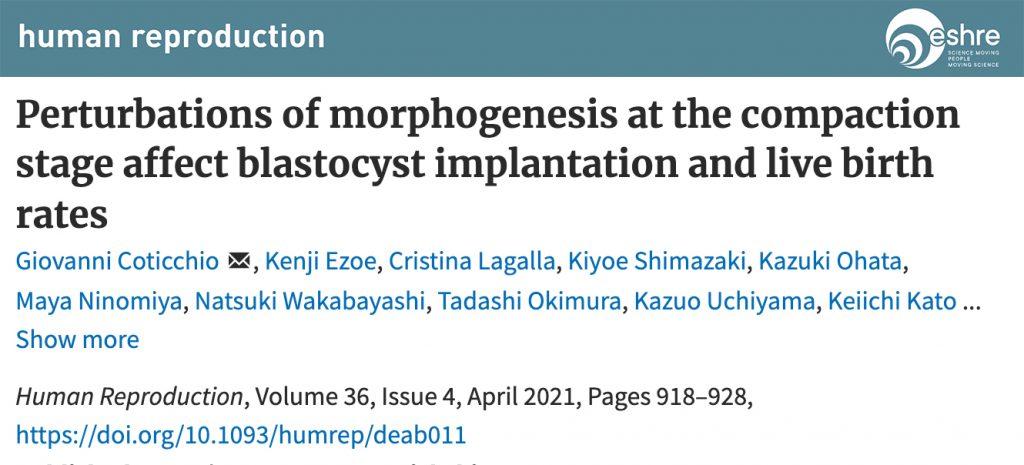
Perturbations of morphogenesis at the compaction stage affect blastocyst implantation and live birth rates
Giovanni Coticchio, Kenji Ezoe, Cristina Lagalla, Kiyoe Shimazaki, Kazuki Ohata, Maya Ninomiya, Natsuki Wakabayashi, Tadashi Okimura, Kazuo Uchiyama, Keiichi Kato, Andrea Borini
Human Reproduction, Volume 36, Issue 4, April 2021, Pages 918 928, https://doi.org/10.1093/humrep/deab011 Published: 12 February 2021
Abstract
Study question: Do perturbations of embryo morphogenesis at compaction affect blastocyst development and clinical outcomes in assisted reproduction cycles?
Summary answer: Cell exclusion and extrusion, i.e. cell disposal occurring respectively before or during morula compaction, affect blastocyst yield and quality, as well as rates of pregnancy and live birth.
What is known already: Despite its pivotal role in morphogenesis for blastocyst organisation and cell fate determination, compaction at the morula stage has received little attention in clinical embryology. Time lapse technology (TLT) allows detailed morphokinetic analysis of this developmental stage. However, even in the vast majority of previous TLT studies, compaction was investigated without a specific focus. Recently, we reported that compaction may be affected by two clearly-distinct patterns of cell disposal, exclusion and extrusion, occurring prior to and during compaction, respectively. However, the crucial question of the specific relevance of partial compaction for embryo development and competence in ART has remained unanswered until now.
Study design, size, duration: This study involved the assessment of laboratory and clinical outcomes of 2,059 morula stage embryos associated with 1,117 ICSI patients, who were treated with minimal stimulation and single vitrified-warmed blastocyst transfer (SVBT) from April 2017 to March 2018. Patterns of morula compaction were assessed and analyzed in relation to embryonic and clinical outcomes.
Participants/materials, setting, methods: Following ICSI, time-lapse videos were analysed to annotate morphokinetic parameters relevant to both pre- and post-compaction stages. According to their morphokinetic history, morulae were classified as: (I) fully compacted morulae (FCM); (II) partially compacted morulae (PCM), showing cells (a) excluded from the compaction process from the outset (Exc-PCM), (b) extruded from an already compacted morula (Ext-PCM), or (c) showing non-compacted cells arisen from both patterns (Exc/Ext-PCM). The number of excluded/extruded cells was also annotated. Possible correlations of compaction patterns with 13 morphokinetic parameters, abnormal cleavage, blastocyst yield and morphological grade, clinical and ongoing pregnancy rates, and live birth rate were evaluated. Other factors, such as patient and cycle characteristics, possibly associated with compaction patterns and their outcomes, were investigated.
Main results and the role of chance: Full compaction was observed in 39.0% of all embryos. However, partially compacted morulae (PCM) showing excluded (Exc-PCM), extruded (Ext-PCM) cells, or indeed both phenotypes (Exc/Ext-PCM) were frequently detected (24.8%, 16.6%, and 19.6%, respectively) and collectively (61%) exceeded fully compacted morulae. Blastomere exclusion or extrusion affected one or several cells, in different proportions. In comparison to FCM, the developmental pace of the three PCM groups, observed at 13 developmental stages starting from pronuclear fading, was progressively slower (P < 0.0001). Developmental delay at post-compaction stages was more pronounced in the group showing both patterns of partial compaction. Blastomere exclusion and/or extrusion had a large negative impact on blastocyst development. In particular, rates of blastocyst formation and cryopreservation were very low in the Ext-PCM and Exc/Ext-PCM groups (P < 0.0001). Rates of blastocysts with ICM or TE of highest quality (Grade A) were severely affected in all PCM groups (P < 0.0001). In 1,083 SVBTs, blastocysts derived from all PCM groups produced much lower clinical pregnancy, ongoing pregnancy, and live birth rates (P < 0.0001). All three patterns of partial compaction emerged as factors independently associated with live birth rate, even after multivariate logistic regression analysis including maternal/paternal age, female BMI, and number of previous embryo transfers as possible confounding factors.
Limitations, reasons for caution: The retrospective design of the study represents a general limitation.
Wider implications of the findings: This large-scale study represents a further important demonstration of embryo plasticity and above all indicates new robust morphokinetic parameters for improved algorithms of embryo selection.
Study funding/competing interest(s): This study was exclusively supported by the participating institutions. The authors have no conflicts of interest to declare.

